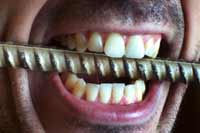 Eating itself often seems the trigger of migraine attacks, not the particular foods I eat (although certain foods are clearly problematic). I’ve explored blood sugar and thyroid angles with no success. Though I’ve had jaw pain forever, I never put the pieces together that jaw tension may be the problem. Fortunately my physical therapist figured it out.
Eating itself often seems the trigger of migraine attacks, not the particular foods I eat (although certain foods are clearly problematic). I’ve explored blood sugar and thyroid angles with no success. Though I’ve had jaw pain forever, I never put the pieces together that jaw tension may be the problem. Fortunately my physical therapist figured it out.
As an outrageously stubborn Type A migraineur, my jaw is locked almost constantly. It has been sore to the touch for as long as I can remember. I’ve worn a mouth guard at night for more than 10 years and even had TMJ surgery* in 1997.
Physical therapy has yielded some key information: The PT’s work on my jaw provides far more immediate relief than when he focuses on my neck. My fascia is healthy, so muscles are the main variable. The tightest, most-difficult-to-relax spot on my neck is where the jaw muscles connect. Ideally, relaxing my jaw will also relieve some neck pain.
Jaw relaxation was a success at my first biofeedback session. Doing it on my own since then hasn’t been so productive. I relax as much as I can, but wish I had the visual feedback so I could know I’m training my muscles correctly.
Treatment plan:
- Learn to relax my jaw and monitor the problematic spot on my neck in individual biofeedback sessions
- Avoid crunchy or chewy foods (for a short time)
- Cut all food into kid-sized pieces
- Learn to chew up and down rather than in a circular motion
- Continue to see my massage and physical therapists for jaw work
- Use self-massage and acupressure to further treat muscles
A guide to jaw and face self-massage is one of my tools. The instructions are clear and graphics show where to focus each technique. The first page of Healing Self-Massage also teaches face and jaw massage. (Full-body self-massage is covered on the next page. I haven’t tried it, but it looks good for overall relaxation.)
This may be a major piece of the puzzle. I’m so confident I’m not even fretting it won’t help. There’s a lot of work before I find relief, but having a concrete and relatively easy-to-implement treatment plan will help. Maybe I’m setting myself up for a fall. At least it is a fall I feel good about.
*My jaw was better for two months before returning to its usual state. I’ve since learned that particular surgery borders on malpractice.
